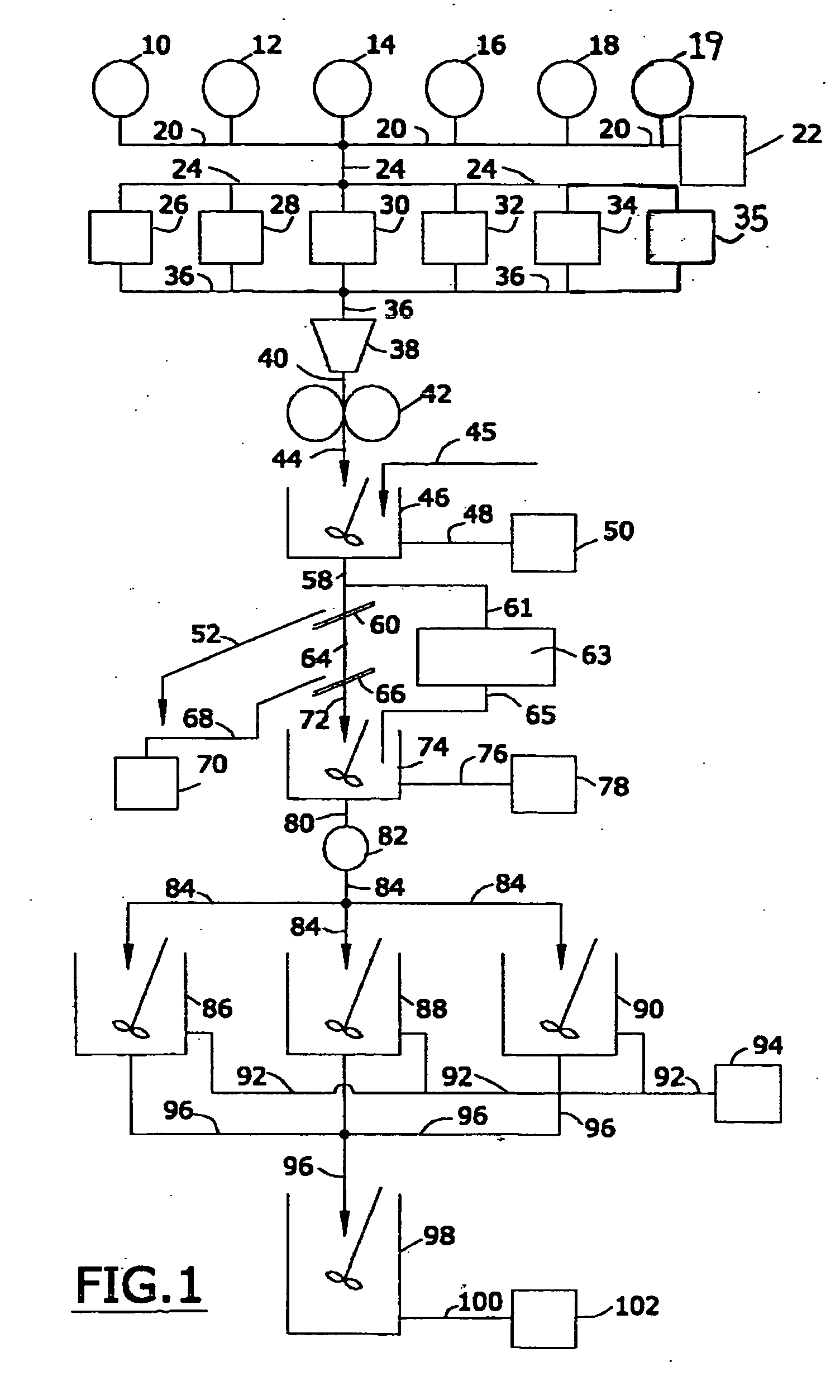Siliceous clay slurry
a technology of clay slurry and clay clay, which is applied in the field ofsiliceous clay slurry, can solve the problems that the slurry described in the kohut patents is not adapted to be used as a slip for casting
- Summary
- Abstract
- Description
- Claims
- Application Information
AI Technical Summary
Benefits of technology
Problems solved by technology
Method used
Image
Examples
example 1
[0246] A highly siliceous crude clay from Gleason, Tenn., called “Chappell Sand Seam,” was used in this experiment and designated as “S6148.” The clay contained 33.75 percent particles smaller than 45 microns, it had a specific surface area of 11.05 square meters per gram, and it contained 27.4 percent of its particles smaller than 0.5 microns. The clay contained at least 66 weight percent of silica.
[0247] Another clay from Henry County, Tennessee was also used in the experiment of this example. The second clay, designated as “S6153,” contained 4.58 percent particles larger than 45 microns, a specific surface area of 27.7 square meters per gram, and it contained 21.4 percent of its particles smaller than 0.5 microns. The clay contained 64.4 weight percent of silica.
[0248] An 80 / 20 mixture of the first / second clay was prepared by first adding the second clay (S6153) to hot water at a temperature of 65 degrees Celsius with blunging, and with the addition of 0.034 percent (by weight)...
example 2
[0250] The procedure of Example 1 was substantially followed, with the exception that different clays were used. These different clays are described in Table 2.
TABLE 2Sample IDFormulaSpecGrav% SSASiO2+325 mesh% carboncasting rateS646725%25.712.3968.223.73S659125%29.813.5961.729.52S575930%29.714.5262.515.21S6199*20%31.629.5864.02.94S6602**1.65530.017.1965.519.880.374112.9
*includes portions of S6152 and S6153
**S6602 slurry was made using 0.286% sodium silicate
[0251] Referring to Table 2, and in the experiment of Example 2, it will be seen clays S6467, S6591, S5759, and mixed sample of S6199 and S6152 and S6153 were mixed together and blunged in accordance with the procedure of Example 1 to produce the slurry of this example (S6602). The slurry had a specific gravity of 1.655, contained 30 percent of particles smaller than 0.5 microns, had a specific surface area of 17.9 square meters per gram, contained 65.5 weight percent of silica.
example 3
Preparation of Casting Slip
[0252] Example 3 describes the preparation of several different casting slips. The casting slip of Example 3 is a “control slip” made in a traditional manner known to those in the prior art. The casting slips of Examples 5 and 6 are made with the slurry of this invention.
[0253] In the experiment of Example 3, a slip was made with “Flo-Tech” slurry. This “Flo-Tech” slurry is sold by the H.C. Spinks Clay Company of Paris, Tenn. The slurry used in this experiment, identified as “WP 1857,” had a soluble sulfate concentration of 295 parts per million, a particle size distribution such that 91.8 percent of the particles were smaller than 20 microns, 82 percent were smaller than 10 microns, 71.6 percent of the particles were less than 5 microns, 55.9 percent of the particles were less than 2 microns, 46.9 percent of the particles were less than 1 micron, 37.4 percent of the particles were less than 0.5 microns. The specific surface area of the slurry was 17.15 ...
PUM
| Property | Measurement | Unit |
|---|---|---|
| weight percent | aaaaa | aaaaa |
| weight percent | aaaaa | aaaaa |
| weight percent | aaaaa | aaaaa |
Abstract
Description
Claims
Application Information
 Login to View More
Login to View More - R&D
- Intellectual Property
- Life Sciences
- Materials
- Tech Scout
- Unparalleled Data Quality
- Higher Quality Content
- 60% Fewer Hallucinations
Browse by: Latest US Patents, China's latest patents, Technical Efficacy Thesaurus, Application Domain, Technology Topic, Popular Technical Reports.
© 2025 PatSnap. All rights reserved.Legal|Privacy policy|Modern Slavery Act Transparency Statement|Sitemap|About US| Contact US: help@patsnap.com

